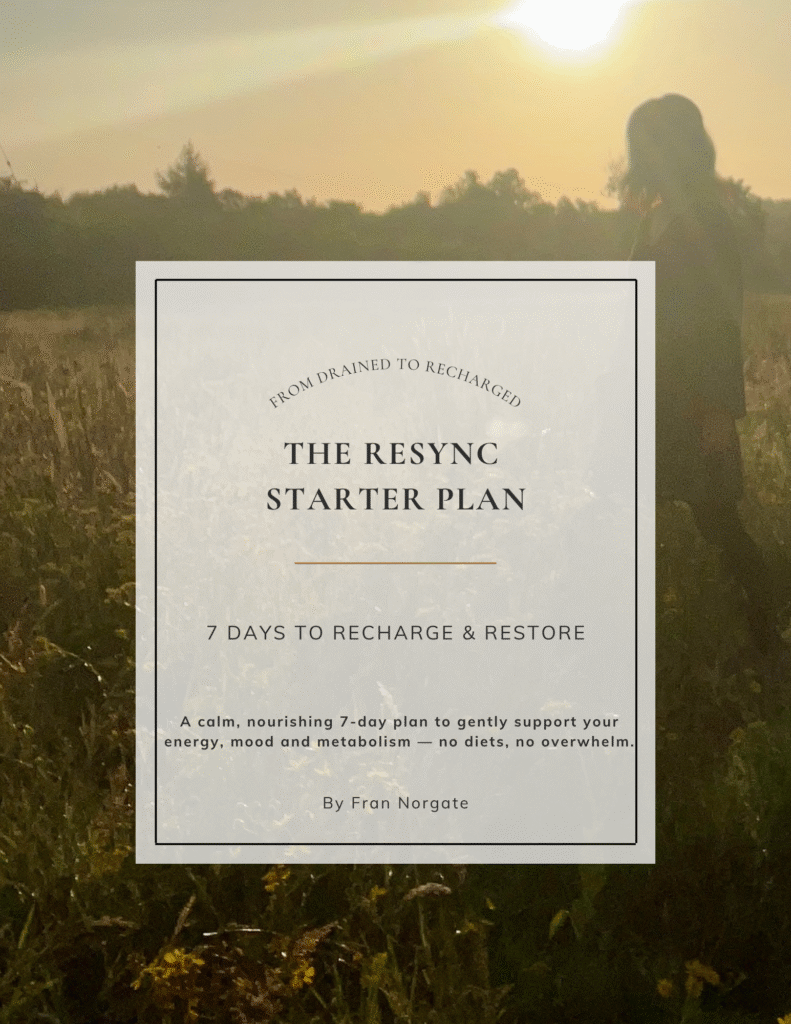Time-Restricted Eating: How Circadian Fasting Can Support Energy, Metabolism, and Hormone Balance
Why Time-Restricted Eating Might Be the Reset Your Body’s Craving
Do you ever feel like you’re running on empty—wired but tired, always reaching for a snack to keep going, yet never quite feeling steady? You’re not alone. Many of us are caught in a cycle of constant grazing, late-night nibbling, and erratic meal times. This can leave our energy flat, our digestion sluggish, and our hormones out of sync. That’s where time-restricted eating (TRE) comes in. TRE isn’t a diet—it’s a way of eating that works with your body’s natural rhythms, rather than against them. And when we align our meals with the daily cycle of light and dark—what’s called circadian fasting—we give our metabolism the steady beat it needs to thrive.
What is Time-Restricted Eating?
At its simplest, time-restricted eating means eating all of your meals within a defined window of time each day and fasting for the remaining hours. Unlike calorie-counting or restrictive diets, TRE focuses on when you eat, not necessarily how many calories you eat.
Our bodies love rhythm. Just as we sleep better when we have a bedtime routine, we digest and metabolise food more effectively when we keep meals within a regular window. TRE helps reset that internal rhythm, so energy, blood sugar, and hormones can work in harmony.
Different Ways to Practise Time-Restricted Eating (TRE)
There isn’t a one-size-fits-all approach—different eating windows work for different lifestyles. Here are some of the most common:
- 12:12 – Eat within a 12-hour window, fast for 12. A gentle starting point, perfect if you’re used to eating breakfast at 8am and finishing dinner by 8pm.
- 14:10 – Eat within a 10-hour window. This might mean breakfast at 8am and dinner finished by 6pm.
- 16:8 – Popular with many, this pattern involves fasting for 16 hours and eating within an 8-hour window—for example, 10am–6pm.
- Early vs Late TRE – Some people prefer an earlier window (say 8am–4pm), while others find a later window (12pm–8pm) works better for their routine.
The key? Consistency. Choosing a window you can realistically stick to is far more beneficial than aiming for perfection and constantly shifting your schedule.
What is Circadian Fasting?
Circadian fasting is a form of TRE that takes our body clock into account. Our metabolism isn’t designed for midnight snacks—it’s wired to process food most efficiently during daylight hours. Eating in line with our circadian rhythm means:
- Front-loading energy: Meals earlier in the day tend to be better metabolised.
- Supporting sleep: Avoiding late-night eating helps melatonin rise naturally, preparing the body for rest.
- Balancing hormones: Cortisol, insulin, and other hormones follow a daily rhythm. Keeping meals in sync with these cycles supports steadier energy and fewer cravings.
Think of it as eating in rhythm with the sun. As light fades, digestion slows down too—so bringing dinner earlier can make a big difference.
The Science Behind Time-Restricted Eating
Research into TRE and circadian fasting is growing fast, with studies showing potential benefits including:
- Improved insulin sensitivity – helping to keep blood sugar steadier.
- Reduced inflammation – supporting long-term metabolic and cardiovascular health.
- Better digestion – giving the gut time to rest and repair overnight.
- Enhanced energy and focus – fewer dips caused by constant grazing or late-night eating.
- Weight and appetite regulation – naturally reducing overeating, without strict calorie counting.
One study even showed that people practising an early eating window (finishing dinner by mid-afternoon) reported significantly reduced hunger compared to eating the same calories later in the day.
How Time-Restricted Eating Looks Inside the Resync Autumn Reset
On day two of the Reset, many participants already start noticing how different life feels without constant snacking. At first, it can feel strange not to reach for something mid-afternoon, but the body adjusts quickly. With balanced meals, steady hydration, and gentle lifestyle tweaks, those cravings start to fade.
Instead of “white-knuckling” through hunger, participants learn to notice true hunger signals versus habitual snacking urges. And this is exactly the essence of TRE—eating in rhythm with the body’s needs, rather than the mind’s habits.
Practical Tips to Try TRE or Circadian Fasting
If you’re curious about giving this a go, here are some gentle ways to start:
- Start small: Begin by shortening your eating window by 30–60 minutes, rather than jumping straight to a 16:8.
- Eat balanced meals: Focus on protein, healthy fats, and fibre to keep blood sugar stable and hunger at bay.
- Stay hydrated: Sometimes “hunger” is actually thirst—herbal teas, water, or sparkling water can help.
- Light exposure matters: Getting outside in morning light helps anchor your circadian rhythm, making TRE easier.
- Wind down in the evening: Reduce screen glare, dim the lights, and bring your last meal earlier when possible.
Is TRE Right for Everyone?
TRE is a supportive framework, but it’s not for every stage of life or health condition. If you’re pregnant, breastfeeding, underweight, or managing certain medical issues, it’s best to get professional guidance before experimenting. For most people, though, starting with a gentle 12:12 or 14:10 window is safe and supportive.
Closing Thoughts
Time-restricted eating and circadian fasting aren’t about rigid rules or “perfect” eating windows. They’re about realigning with the natural rhythm your body already knows. By eating in sync with daylight, we give our metabolism, hormones, and nervous system the structure they need to restore balance.
It’s less about restriction and more about rhythm. And when we give our bodies rhythm, we often find that energy, focus, and steadiness return more naturally than we imagined.
If you’d like to experience this in real time, you can follow along by signing up to my newsletter, where I share insights into the latest nutrition science while keeping the beneficial ancestral practices in place. You will be the first to find out about the next reset programme and any upcoming offers too!
Want to start with a Completely FREE 7-Day Guide?
Ready for 1:1 Support?

Ready to Feel More Like
You Again?
The Resync Starter Plan is your free guide to gently restoring energy, balance, and clarity—without diets, overwhelm, or starting from scratch.
Inside, you’ll find:
- Simple shifts to support your hormones, digestion, and nervous system
- Calming rituals to help you feel grounded in a busy world
- A rhythm that fits real life—not another rigid health plan
It’s like a warm cuppa and a deep breath… for your body and mind.
👉 Download your free copy now and take your first step back to balance.

